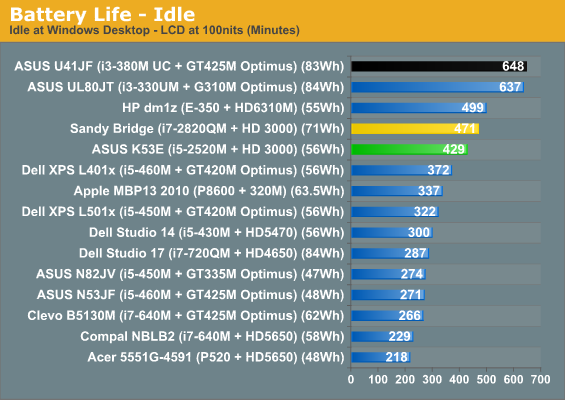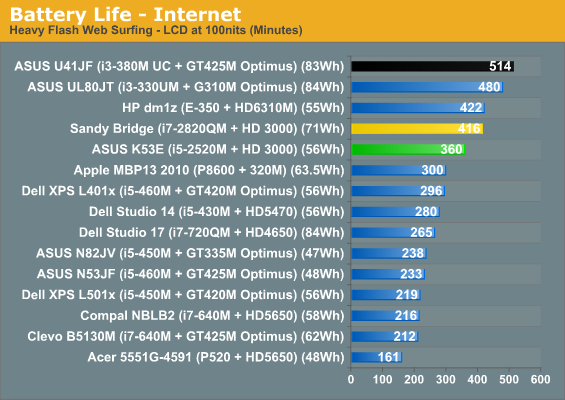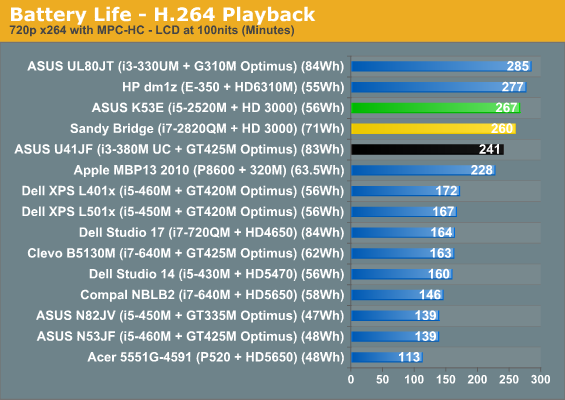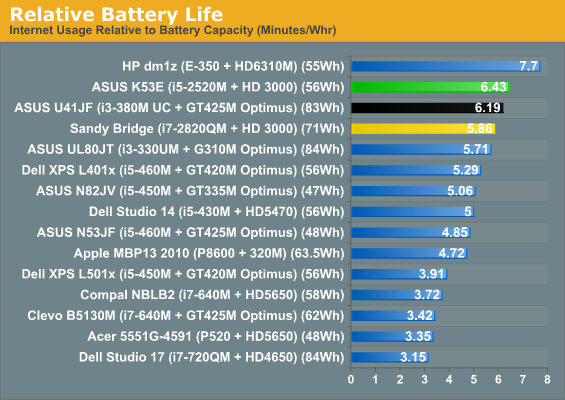ASUS K53E: Testing Dual-Core Sandy Bridge
by Jarred Walton on April 8, 2011 1:00 AM EST- Posted in
- Laptops
- Intel
- Sandy Bridge
- Asus
Battery Life: Minor and Major Improvements
As mentioned earlier, ASUS finally moved to something slightly higher capacity than the 48Wh batteries we’ve seen in so many entry-level notebooks. The result is better battery life, but compared to Arrandale it’s not a huge change in two of our tests. The third test is H.264 playback, and that shows a large increase in battery life. We’ve got the same laptops that we used in our application tests for these charts, but if you want more comparison points we suggest checking out Mobile Bench, where we have results for every laptop we’ve tested in the past year. For example, here’s how the K53E stacks up to one of the few Arrandale-only laptops we’ve tested, the Dell Latitude E6410.




The ASUS K53E places near the top of our battery life charts, with over seven hours of idle battery life, six hours of Internet surfing, and almost 4.5 hours of H.264 video playback. There’s still a sizeable gap between the K53E and laptops like the U41JF, but that’s more a case of battery capacity than efficiency. With a similar size battery capacity (and a much smaller LCD), HP’s dm1z does last over an hour more in the idle and Internet tests. H.264 content is a place where Sandy Bridge excels, however, and with only a 10 minute difference between the 11.6”-screen HP dm1z and the 15.6”-screen ASUS K53E it’s pretty clear that’s one metric where SNB is more efficient. Looking at relative battery life (i.e. true power efficiency), the K53E is only bested by Brazos (and Atom and CULV) in the Internet test. Even the U41JF can’t match the K53E for efficiency, despite underclocking the i3-380M to 700-900MHz (instead of the normal 933-1200MHz) and having a smaller 14” LCD.
For other battery life tests, the K53E lasted just 73 to 83 minutes in simulated gaming (looping 3DMark06/03, respectively), so at heavy loads SNB clearly isn’t a panacea. Setting the LCD to 100% brightness (instead of 50%, which corresponds with 100nits), idle battery life drops 10%. Put another way, the LCD uses an extra 0.87W at 205nits. That’s a very low figure for a 15.6” LCD, but then the maximum brightness isn’t very impressive and as we’ll see shortly, the LCD is otherwise a complete disappointment. Calculated power draw at idle running on battery power is just 7.91W, which used to be Atom territory (though the ASUS Eee PC 1001P drops that figure to just 4.4W). Internet surfing bumps the average power use to 9.33W, which is still extremely good, and H.264 playback requires 12.58W. We’re basically looking at 6-15 times the performance of Atom (Pineview), all while requiring just 40-80% more power at low loads. Connecting the AC adapter, we saw slightly higher power draw at the outlet, but mostly that comes from the AC adapter efficiency.
There are a couple final points before we leave power and battery life discussions. First, all of this testing was done with a stock Windows 7 installation, so we didn’t use ASUS’ Power4Gear utility to further optimize power requirements (e.g. by shutting off the DVDRW on battery power). In the past, that has usually added at least a few percent to the battery life, which is one of the reasons ASUS’ current laptops often beat their competitors.
The other interesting piece of information is that with Core 2 and Core 2010, we always achieved maximum battery life by setting the CPU to run at 0% minimum and 0% maximum in the advanced power settings (as opposed to 0% min/100% max). With Sandy Bridge, idle battery life still benefits slightly, but it’s within the margin of error (425 vs. 429 minutes); H.264 playback is also within the margin of error (261 vs. 267 minutes), but this time setting the CPU to 0% min/100% max results in the higher battery life. The real kicker is the Internet test: set to 0/0%, the K53E lasted 311 minutes compared to 360 minutes at 0/100%. In other words, with Sandy Bridge it looks like the “hurry up and go to sleep” principle is finally working as intended. This is a pattern we’ve noticed on other SNB laptops, so you can now get the benefits of faster instantaneous performance and better efficiency, at least when you’re running light loads.











78 Comments
View All Comments
JarredWalton - Saturday, April 9, 2011 - link
Brazos C-50 starts at $325, so it's within spitting distance of the Atom N550 (dual-core), and it still has a substantially better IGP -- though it's mostly useful for video as opposed to gaming on the C-50. C-50 is also a lower power and better battery life option, though it may not match the best Atom netbooks. Still, I'm not sure most people need more than 10 hours of battery life, which is what we're talking about at this point.AMD's E-350 is better/faster, but it's also more expensive. I'd be quite surprised if Atom netbooks offered better audio latency. Only thing really missing is a good ASUS equivalent of the 1001P, only with C-50. Right now, the only 10.1" C-50 (or Brazos) netbook comes from Acer, who doesn't have the best reputation. If you're interested, though, the Acer Aspire One 522 is on sale for $300 at Micro Center right now.
krumme - Sunday, April 10, 2011 - link
Have you ever tried an Atom? - if i would say you are a very patient man :)There is absolutely none in my family, with very patient female computer users i tell you, who havnt complained about the speed for basic task like surfing and office use.
In my entire life i have met one person who didnt complain - all other - who thought all computers were the same - have complained. Atom just showed them - who did forget about the old age and windows 95 on 8Mb ram, that computer actually can be different.
What i am pretty comfident about is, that all those user would have been pretty sattisfied with an e350, and stayed in their beliewe there was no difference.
I think it just underlines that Intel and AMD have trouble for the future. The cpu/gpu is just fine as they is now. Then there is just the fight for cost, and it means lower earnings on the traditional markets.
strikeback03 - Monday, April 11, 2011 - link
I was perfectly happy with the one Atom system I have used extensively - the carputer I built in my last car was based around an Atom 330. with 1GB RAM and a 200GB 7200 RPM HDD the only time there was ever any delay running the Centrafuse front-end interface was when a module was first loading after a restart. So for limited uses Atom is fine, so long as the software and experience are designed for that level of performance.krumme - Monday, April 11, 2011 - link
Yeaa, and my atom stream audio fine, and does not feel slow as long as i do not touch it.Atom was not build for anything but tv boxes, competing with arm. And therefore it does not work when anandtech, promotes sb at the expense of bobcat, because it indirectly leads the consumers to tv box computer power. And that is the unintended effect of theese articles.
JarredWalton - Monday, April 11, 2011 - link
So Atom running a custom OS will be much better, obviously. Heck, even Atom chips (by PC standards) are going to be twice as fast as the best smartphone chips -- not on the GPU side, though, but that's a different story. But if you were to go out and buy a laptop for use as a Windows PC, there's still a big gap between $400 laptops and $700 laptops -- more than a 2X increase in performance for less than double the price.My experience is that given the choice (i.e. money not a consideration), no one would want less performance from their laptop. SNB dual-core should be good enough to fit in 13.3" laptops that weigh around 4 lbs., and priced at around $800 (or less) that's a great portable PC. Bobcat will go into smaller devices and offer slightly better battery life, but it's still slower (too slow) on some tasks -- e.g. video transcoding, Flash browser games, and anything else that's computationally intensive will be much better on SNB. So again, Brazos is basically for those who value price more than most other areas.
On a related note, I'd be shocked if any major business tried to replace current generation Arrandale laptops with Brazos laptops. Heck, they wouldn't even replace Core 2 Duo laptops with Brazos. Businesses want a balanced laptop, generally speaking, and right now Intel gives you more performance with good battery life for a reasonable price. AMD competes on the desktop and laptop with lower prices, but when productivity is money, why would you save $150 only to have your employees waste hours of time over the next year? (Well, they'll waste time regardless, but they'll waste even *more* time waiting for a slow computer.)
Long-term, it will be very interesting to see what happens with Windows 8. Windows 7 can run on Atom, but it's clearly a different experience than Win7 on even something like CULV or Brazos. ARM-based SoCs are sort of Brazos, except they're even slower on the CPU side of the fence (and slower on GPU as well). Win8 will need some major changes relative to Win7 to make it viable on tablet and laptop devices running such SoCs.
krumme - Tuesday, April 12, 2011 - link
IT is not a strategic subject for top management anymore.A few years back, they would spend time talking TCO, cost outsourcing, but today is different.
They just dont want to hear about it, and spend valuable time on it. For good reason.
SAP is running for everyone and his brother, the oursourcing is in place. Who cares if its a Dell or HP machine except in IT.
And the IT director, who ofen is an economis, hardly knows what a CPU is. It matters so little no one cares just a few stop up the chain.
The replacement of computers is just done regulary say every 3 years, and what Dell/HP chooses to put in their computers is their business.
If something is interesting about the computers today its screen, keyboard, battery and foremost quality.
The cost differences for a brazos compared to a sb is so slim, it doesnt matter. But lets say the next brazos 28nm q4?, have nearly double the batterylife and a solid turbo, then i think there is a chance we will se a lot of ultra portable business laptops with them.
Except for 10% of the business users i think we are waiting for the HD not the cpu. Therefore i think we will se more cheap ssd and even more noise and battery friendly cpu/gpu in the next generation - standard roll out - business leasing deals.
But as said, for the professional side its just mostly TCO today, and for the consumer side its just more and more cost, cost, cost. Perhaps they are saving for an IPAD3 ? :)
tomycs2007 - Monday, April 11, 2011 - link
"15.6" WLED Glossy 16:9 768p (1366x768)(AU Optronics B156XW02 v6)"
TegiriNenashi - Monday, April 11, 2011 - link
As long as its display has puny vertical 768 pixels resolution. Please bring back 16:10 aspect ratio!